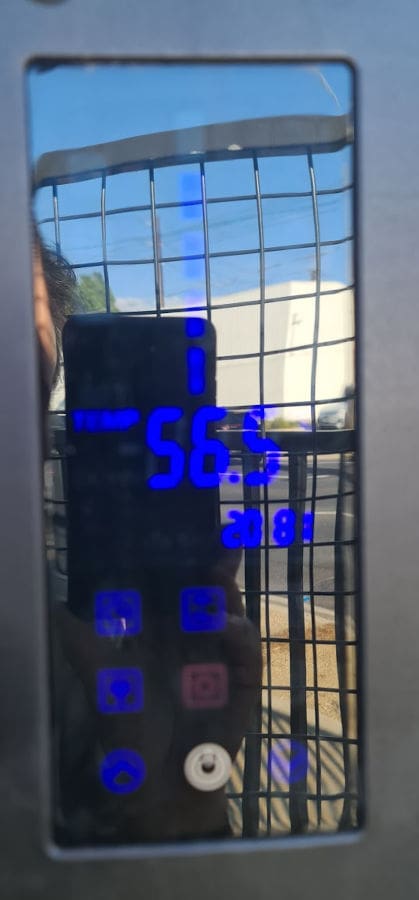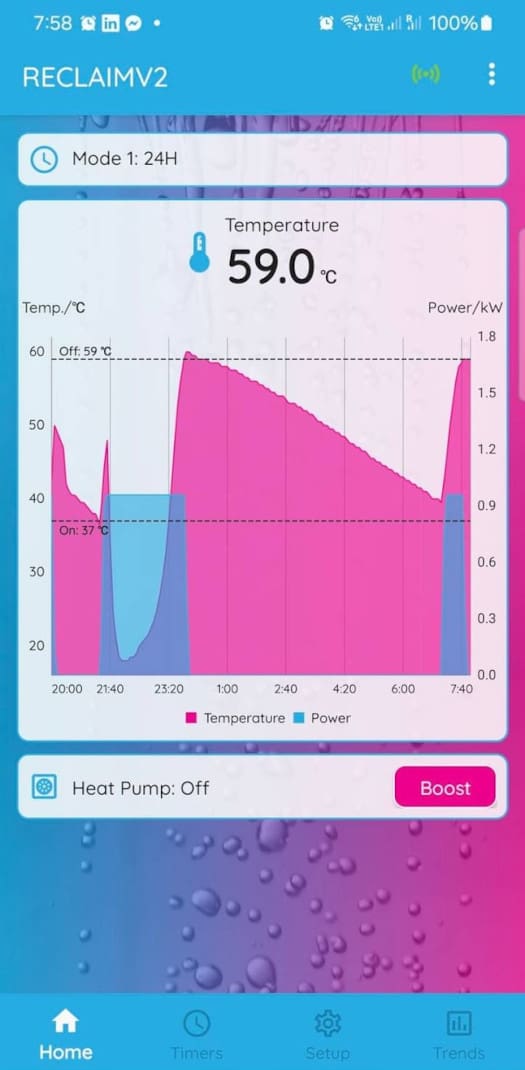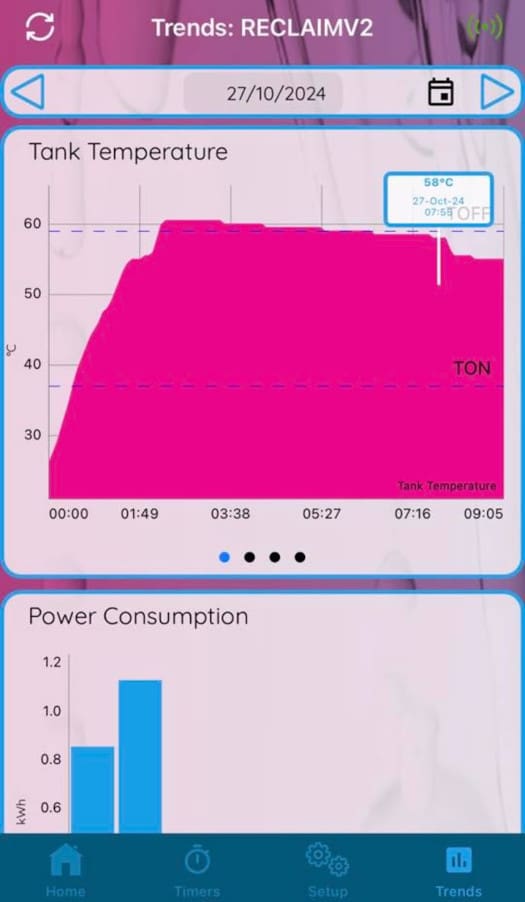Does Your Hot Water Need Wi-Fi?


I inadvertently brought a flyer home from a trade show recently, and my wife did a double take that stopped her and the recycling process in its tracks. She was fascinated and horrified at the WiFi control logo on this hot water tank
“I can’t even have a shower in peace now…WHY ! does hot water need WiFi?“
How else are the hackers going to steal your shower thoughts or pump up the profits of Big Deodourant Inc?
That explanation didn’t fly, but it did hatch the idea for this post.
Though at first blush it sounds like a gimmick, everything needs the internet now, especially when it might represent 30% of your household energy consumption.
We’re Dealing With Stored Energy
Though your tank is always full of water, the temperature will vary. As you draw off the hottest water from the top, cold water enters from the bottom and rises gently through the tank in a stratified layer.
Of course that governs how much time you can spend under the shower. If your fellow housemates have just been through, there may only be a few litres of warmth left before the cold layer gets to the top, and the outlet pipe runs cold.

Ye Olde hot water schematic showing how stratification produces layers in the tank. A divorced heat pump can be installed in place of the wood fire.
Simplicity Is The Ultimate Refinement
Traditionally, your hot water cylinder had a simple resistive element in the bottom, connected to a controlled load (i.e., off-peak) electricity. Convection stirred up the water until the entire tank was hot enough to turn the thermostat off, and everything settled again, ready for you to draw off the hottest water from the top in the morning.
At 3.6kW, it’s probably 40% larger than your kettle. When the controlled load circuit was energised, this element would fizz with about 15amps of current. That was half of the grid connection capacity when houses were first electrified.
The element would run for an hour or three depending on the amount of water used since the last heating cycle and the ambient temperature.
Fun Fact; A properly efficient Passivhaus design & building process means the heat that “leaks” gradually from a hot water tank will be accounted for inside the house. If your house if properly built, 1.5 to 3kWh/day is a useful amount of winter heating that’s otherwise lost if the tank is outside.
Either way it’s easy to imagine 3h x 3.6kW = 10.8kWh and in today’s money (23c/kWh) that’ll be $2.50 thanks
Some units have a second element, placed partway up, to heat the top ⅓ of the tank. This was connected to the anytime tariff and would only come on as a booster.
WiFi Offers Monitoring
If you have an app with your hot water heater, you’ll know how much energy is in your tank. This is very handy if, say, you have a CatchControl that can be triggered remotely to heat up before you get home from a holiday. It can also show how much energy a hot cycle for your washing machine uses.
As we move toward a flexible, renewable-powered grid, daytime solar will be the cheapest energy source. So, if you’re on your way home from work and have an appetite for a spa bath, knowing the whole tank is already hot can be a boon.
If you’re running a motel or rental property, there are even options to monitor a fleet of units.

Not my favourite hot water service. IMO the user interface is dreadful.
WiFi Offers Control
Not every house has solar or a roof to bolt it onto. If you have a Time Of Use retail electricity plan, then changing the timer function remotely is great.
My recent first-hand experience with a Rheem heat pump was enough to swear me off them for life. Pressing buttons with indecipherable pictures to navigate complex menus was nigh on impossible. Consulting the poorly translated instructions wasn’t much better. Little wonder the plumber hadn’t set it up correctly.

Terrible photography was the least of my worries here. There are 8 or more non-tactile “buttons” with ambiguous pictures. Worse still, they change colour, but there’s nothing to indicate if brown or blue is meant to indicate “ON” or “OFF”
WiFi Can Diagnose Problems
Perhaps you have a spendthrift shower hog in your house? Maybe the minister for finance is an energy beancounter? WiFi might not help with the conflict, but it will provide evidence for the murder case.1
In all seriousness, though, we have two screenshots that tell a story here.
Firstly, there’s a brand new installation of a divorced hot water heat pump, where the compressor unit (the heat source) is separate from the tank. The customer was unhappy with its performance, and the monitoring showed what was wrong at a glance. The standing losses were horrific.

Losing 20ºC overnight is a pretty steep curve.
This particular installation was a little unusual. The plumber placed the compressor higher than the tank, which meant the hot water was thermosiphoning from the tank back through the compressor. When it wasn’t running to create heat, it was sapping off the stored energy.
A simple non-return valve would easily fix this, but diagnosing it would have been more difficult without the graph.
What really cinches the case is a graph from a similar model that used a conventional layout. Standing losses are much lower; and much more obvious when you have a picture to explain it.

Perhaps there’s 5ºC lost here between 2am & the first shower at 7:30am
Another Thing To Integrate
I would recommend that if you’re planning a new hot water service, solar power, EV charging, or any number of electrification technologies, the best way to keep them all under control is a dedicated internet router and WiFi network. Run cables where you can to permanently connect things. An hour’s labour running a communication wire will be repaid the first time you don’t have to call out a technician for a Wi-Fi problem.
Where there’s no option for a cable, WiFi will, of course, do. However a router dedicated to energy things means when you change telco or NBN plan, all the tricky setup can be plugged straight back in without re-commissioning.
Footnotes
- Don’t laugh too much. I know a bloke who was labelled “an energy Nazi” during his divorce proceedings. The resulting child custody difficulties mean he’s a changed man in his new family home, with TWO hot water tanks ↩
Original Source: https://www.solarquotes.com.au/blog/wifi-hot-water/


















